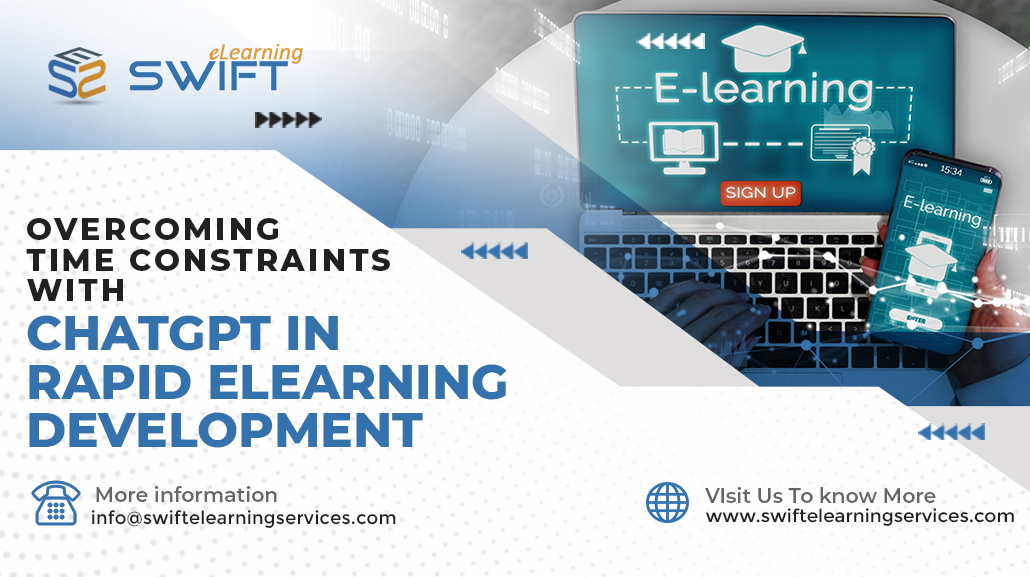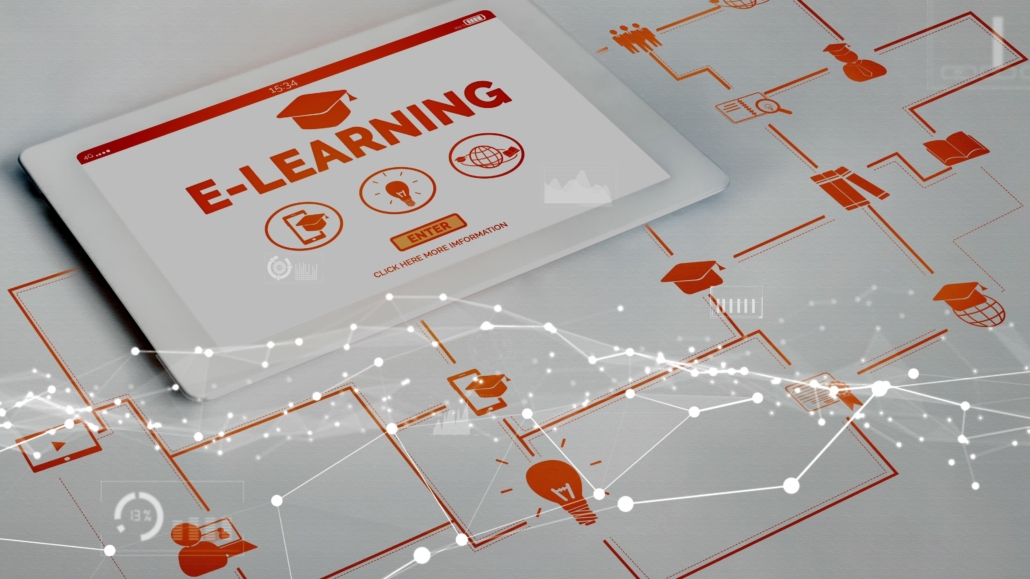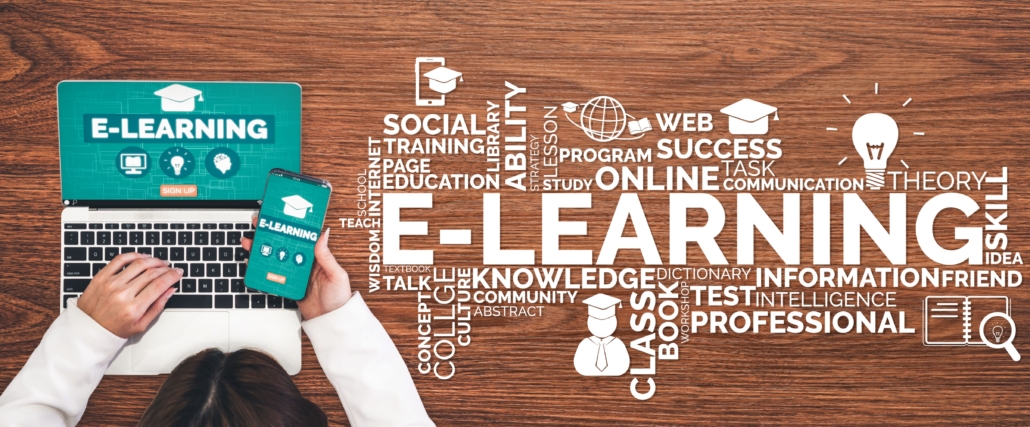Overcoming Time Constraints with ChatGPT in Rapid eLearning Development
Discover how ChatGPT revolutionizes rapid eLearning development, helping you overcome time constraints. Enhance productivity, engage learners, and create high-quality content with this powerful AI tool.
In today’s fast-paced world, where time is of the essence, it can be challenging to develop high-quality eLearning content within tight deadlines. However, with the advent of advanced artificial intelligence (AI) technologies, such as ChatGPT, overcoming time constraints in rapid eLearning development has become more achievable than ever before.
ChatGPT, powered by OpenAI, is a state-of-the-art language model that can assist instructional designers, content developers, and subject matter experts in creating engaging and interactive eLearning materials efficiently.
In this article, we will explore how ChatGPT can help overcome time constraints in rapid eLearning development, providing you with the tools and strategies to enhance your productivity and efficiency.
Before we dive into today’s blog topic, let us first understand what rapid eLearning development is and the benefits of rapid eLearning development.
1. Understanding Rapid eLearning Development
Rapid eLearning development is a methodology that aims to streamline the process of creating digital learning content quickly and efficiently. It involves leveraging technology, templates, and pre-existing content to accelerate the development cycle, allowing organizations to deliver timely and effective training programs.
The benefits of rapid eLearning development are numerous:
1.1 Time Efficiency
Rapid eLearning enables organizations to develop and deploy training materials in significantly shorter timeframes compared to traditional methods. This is particularly beneficial when there is an urgent need for training or when frequent updates are required.
1.2 Cost Savings
By reducing development time and resources, organizations can achieve cost savings. Rapid eLearning eliminates the need for lengthy development cycles and extensive use of specialized personnel, resulting in reduced costs associated with content creation.
1.3 Flexibility and Agility
Rapid eLearning allows for quick adaptation to changing training needs and evolving content. It enables organizations to respond promptly to market dynamics, regulatory changes, or emerging training requirements.
1.4 Accessibility and Scalability
With rapid eLearning, organizations can reach a larger audience by delivering training content anytime and anywhere. It facilitates the creation of online courses that can be accessed globally, enabling learners to engage in self-paced learning at their convenience.
1.5 Engaging Learning Experiences
Rapid eLearning offers various interactive elements, multimedia integration, and gamification features that enhance learner engagement. These elements contribute to higher knowledge retention and a more enjoyable learning experience.
1.6 Standardization and Consistency
Rapid eLearning allows for the creation of standardized content templates, ensuring consistency across training materials. This consistency is particularly important when delivering compliance training or when multiple trainers are involved.
1.7 Continuous Improvement
Rapid eLearning facilitates a cycle of continuous improvement. As organizations gather feedback and track learner performance, they can quickly iterate on the content, making necessary revisions and updates to enhance its effectiveness.
Basically, rapid eLearning development provides organizations with a time-efficient, cost-effective, and flexible approach to training and development. By leveraging technology and streamlined processes, organizations can deliver engaging and impactful learning experiences while adapting to changing business needs.
2. The Role of ChatGPT in Rapid eLearning Development
ChatGPT serves as a valuable assistant in rapid eLearning development, streamlining the content creation process and expediting production timelines. Its natural language processing capabilities enable it to generate coherent and contextually appropriate text, making it an ideal tool for creating instructional content, quizzes, assessments, and interactive simulations. By leveraging ChatGPT’s capabilities, instructional designers and content developers can save significant time and effort in the development of eLearning materials.
2.1 Generating Content Ideas and Outlines
One of the initial challenges in eLearning development is brainstorming ideas and structuring the content. ChatGPT can assist in this process by providing creative prompts and suggestions for various topics related to the learning objectives. With its ability to generate human-like text, ChatGPT can propose different approaches and perspectives that can inspire instructional designers to create engaging and informative content.
2.2 Writing and Editing Content
Writing and editing content is a time-consuming task that requires careful attention to detail. ChatGPT can aid in this process by generating initial drafts based on the provided guidelines and objectives. By providing prompts and context, ChatGPT can produce paragraphs, bullet points, or even entire sections of content that can be further refined and edited by instructional designers. This collaborative approach between human experts and AI assistants accelerates the content creation process, allowing for rapid iteration and refinement.
2.3 Creating Interactive Assessments and Simulations
Engaging assessments and simulations play a crucial role in eLearning to reinforce learning outcomes and measure learners’ understanding. ChatGPT can assist in the creation of interactive quizzes, simulations, and scenario-based assessments that provide learners with hands-on experiences. By leveraging ChatGPT’s natural language processing capabilities, these assessments can offer personalized feedback and adapt to learners’ responses, enhancing the overall learning experience.
3. Overcoming Time Constraints with ChatGPT
The integration of ChatGPT in rapid eLearning development provides several key benefits that help overcome time constraints and increase productivity. Let’s explore some of these benefits and strategies for efficient eLearning development:
3.1 Rapid Content Iteration and Feedback Incorporation
ChatGPT enables rapid iteration in content development. Instead of spending hours crafting and revising content from scratch, instructional designers can leverage ChatGPT to generate initial drafts quickly. These drafts can be refined through an iterative process that involves incorporating feedback from subject matter experts, stakeholders, and learners. By integrating their insights and expertise into the content, the final product can be further improved and polished within shorter timelines.
3.2 Automated Proofreading and Error Correction
Proofreading and error correction are crucial steps in the content development process. However, these tasks can be time-consuming, especially when dealing with lengthy eLearning materials. ChatGPT can assist in automated proofreading, helping identify spelling and grammar errors, punctuation mistakes, and awkward sentence structures. By reducing the time spent on manual proofreading, instructional designers can allocate their efforts towards more critical aspects of the eLearning development process.
3.3 Enhanced Learner Engagement
Engaging learners is vital for effective eLearning. With ChatGPT, instructional designers can create interactive and immersive learning experiences that captivate learners’ attention. By incorporating conversational elements and simulations powered by ChatGPT, learners can actively participate in the learning process, leading to increased engagement and knowledge retention.
3.4 Time-Efficient Assessment Creation
Assessment creation is an integral part of eLearning, but it can be time-consuming to develop a variety of assessments to measure different learning objectives. ChatGPT can assist in generating multiple-choice questions, fill-in-the-blank exercises, and even scenario-based assessments that simulate real-world situations. By leveraging ChatGPT’s capabilities, instructional designers can save time in creating diverse assessments while ensuring alignment with the learning outcomes.
4. Conclusion – Overcoming Time Constraints with ChatGPT in Rapid eLearning Development
Overcoming time constraints in rapid eLearning development is no longer an insurmountable challenge. With the assistance of ChatGPT, instructional designers and content developers can streamline the content creation process, enhance learner engagement, and save valuable time.
By leveraging ChatGPT’s capabilities, eLearning professionals can meet tight deadlines while delivering high-quality, engaging, and interactive eLearning experiences. Embrace the power of AI in eLearning development and unlock a new level of efficiency and productivity.
5. FAQ’s About Overcoming Time Constraints with ChatGPT in Rapid eLearning Development
How can ChatGPT be customized for industry-specific corporate training programs?
ChatGPT can be customized by training the model with industry-specific data, incorporating industry jargon and examples, and curating relevant content tailored to the specific needs of the industry.
What are the benefits of customizing ChatGPT for corporate training?
Customizing ChatGPT for corporate training enhances relevance, engagement, and knowledge retention. It allows organizations to address industry-specific challenges and provide employees with contextually appropriate learning experiences.
How can organizations overcome the challenges of customizing ChatGPT?
Organizations can overcome challenges by ensuring data availability, addressing data bias, leveraging domain expertise, and maintaining the model through regular monitoring and refinement.
What are the best practices for customizing ChatGPT?
Best practices include defining learning objectives, curating industry-relevant content, training ChatGPT with industry-specific data, incorporating industry jargon, and monitoring and refining the training process.
How can customized ChatGPT benefit the healthcare industry?
Customized ChatGPT can provide healthcare professionals with instant and accurate information about medical procedures, drug interactions, and disease management. It becomes a valuable resource for on-demand knowledge in the healthcare field.
What are the key considerations in customizing ChatGPT for the finance industry?
Customizing ChatGPT for the finance industry involves incorporating financial terminology, investment strategies, risk management techniques, and regulatory frameworks. It provides finance professionals with insights, analysis, and compliance guidance.






